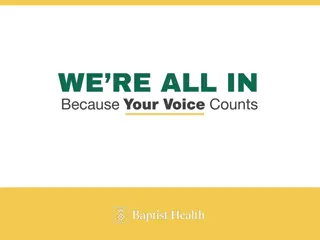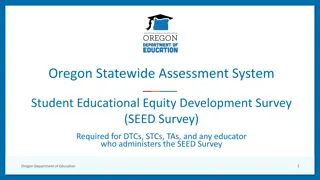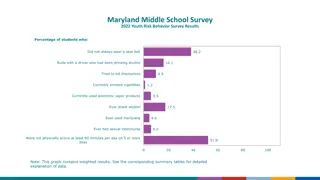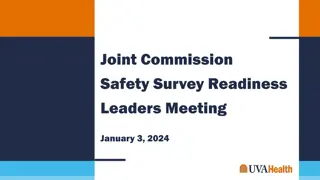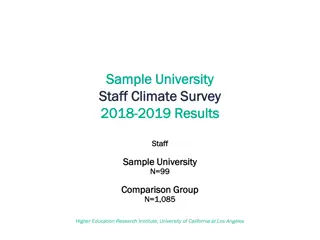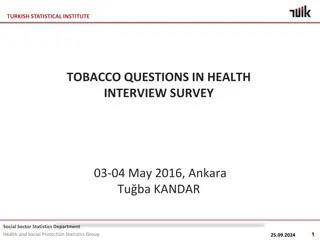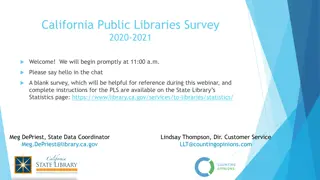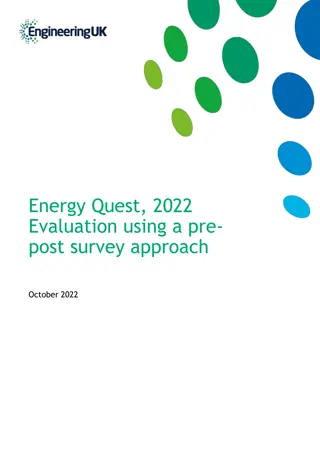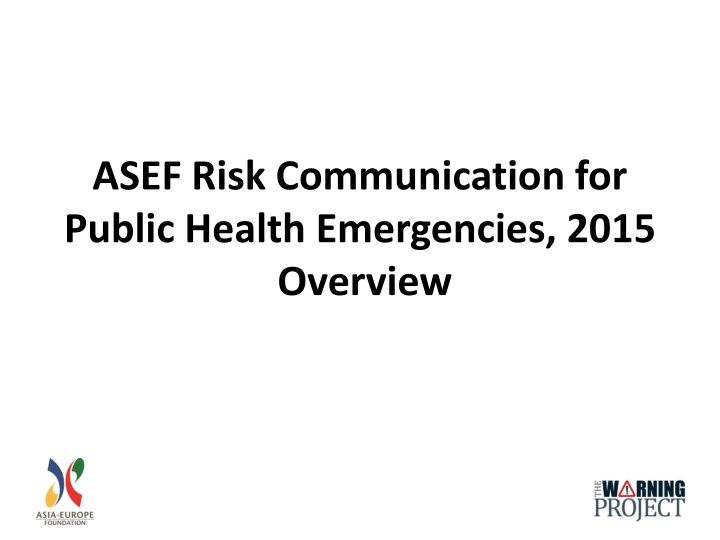
Risk Communication for Public Health Emergencies - ASEF 2015 Overview
Explore the overview of Risk Communication for Public Health Emergencies workshop held in 2015 by ASEF, focusing on key objectives, modules, structure, and survey results regarding emergency risk communication definitions and role assessments. Dive into expert insights and strategies for effective risk communication in healthcare crises.
Download Presentation

Please find below an Image/Link to download the presentation.
The content on the website is provided AS IS for your information and personal use only. It may not be sold, licensed, or shared on other websites without obtaining consent from the author. If you encounter any issues during the download, it is possible that the publisher has removed the file from their server.
You are allowed to download the files provided on this website for personal or commercial use, subject to the condition that they are used lawfully. All files are the property of their respective owners.
The content on the website is provided AS IS for your information and personal use only. It may not be sold, licensed, or shared on other websites without obtaining consent from the author.
E N D
Presentation Transcript
ASEF Risk Communication for Public Health Emergencies, 2015 Overview
Objectives 1. Share experience and expertise 2. Understand the importance and challenge of reflecting the voices of healthcare workers in national risk communication 3. Isolate key barriers too implementing national risk communication strategies 4. Develop recommendations for strengthening national risk communication strategies
Modules 1. Transparency 2. Coordination 3. Dialogue 4. Evaluation
Structure 1. Simulation / Scenario 2. Workgroup challenges 3. Setting the Stage 4. Speakers and Panelists 5. Workgroup recommendations
ASEF Risk Communication for Public Health Emergencies, 2015 Pre Workshop Survey Results
Among the below, which definition of emergency risk communication best reflects your current understanding? 1. Risk communications is a process that gives the public access to information on the emergency and advises them on protective behaviours they should adopt to minimize their exposure to potential risks. 2. Risk communication is a dialogue between those responding and those affected and is supported by the dissemination of essential information that informs critical decision making. 3. Risk communications is an interactive process of information/ opinion exchange between certain individuals, groups and institutions that occurs before a specific health problem/emergency is addressed. 14 46.7% 10 33.3% 6 20%
COMMENTS There is a fourth option missing which includes engagement before an incident this is an ideal , not often easy to achieve e.g. during the tense and rapidly evolving situations of a crisis/emergency, where it can be difficult to have this dialogue , . we don't use the terminology "risk communication", we include this approach into "health promotion". Risk communication should be more than an "opinion exchange".
The response that best describes the role emergency risk communication plays in your programme or specific area of work is... 1. Emergency risk communication is entirely integrated in my programme/area of work.... 2. The role that emergency risk communication plays varies . 10 33.3% 16 53.3% 3. We employ emergency risk communication expertise and strategies to help us develop posters, information pamphlets and brochures similar to health promotion. 4. We do not engage in risk communication 1 3 3.3% 10%
COMMENTS I feel like our countries emergency risk communication is not so finished that it can be integrated into all the areas of work. We often lack the resources to incorporate emergency risk communication into our programmes. Ebola is presenting a window of opportunity currently, bringing the issue of failure to communicate and engage with the affected to the table. We are working to develop specific tools and methodologies for a humanitarian anthropology and a humanitarian health promotion.
Top priority activities in your current risk communication strategies 1. media relations 2. IEC materials 3. social media 4. community engagement 5. social mobilization
Does your programme, team or organization have a list of communication partners? If so, are you in regular contact with these partners? Yes No Somewhat 19 6 63.3% 20% 5 16.7%
Has your programme, team or organization conducted research on the knowledge, attitudes and perceptions of some of your target populations (ie. vulnerable communities, target groups, etc) ? Yes No Somewhat 12 13 40% 43.3% 5 16.7%
Has your programme, team or organization put in place a system for evaluating the impact of your communication strategies/activities to see if they are working? Yes No Somewhat 9 15 30% 50% 6 20%
COMMENTS We try to pre test our messages/materials (but do not Always have the time to do so) We developed indicators of monitoring of our activities, impact is very difficult to measure, but other factors can be monitored. Evaluating the impact of the communication activities is limited by the fact that these are often not implemented directly by us. These activities require significant resources to invest.
On a scale of 1-5, how would you currently classify your country or organization's level of risk communication preparedness? We are not prepared: 1 2 3 4 5 0 3 10 15 2 0% 10% 33.3% 50% 6.7% We are very prepared:

